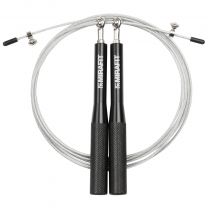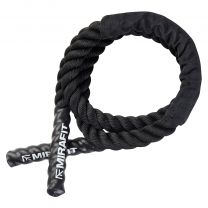When Is The Best Time To Do Cardio?
When Is The Best Time To Do Cardio?

Cardio is without a doubt an essential part of any training routine. Not only is it important for keeping your heart healthy, doing cardiovascular exercise on a regular basis helps to prevent many serious diseases which can affect you later on in life. It’s also great for combating stress and gives you a well-deserved boost of happy hormones.
Getting the balance right between weight and cardio training can be trickier than it seems. Do too much cardio and you can end up eating into your hard-earned muscle mass. Do too little cardio and you don’t get the benefits of calorie and fat burning as well as a healthier heart.
So, what’s the best way of fitting cardio into your training regime so that you can achieve optimum results? When’s the best time to do cardio? And how long for?
Luckily, the Mirafit team has the answers…
HOW MUCH CARDIO SHOULD I DO?

How much cardio you fit into your regime is really about what your goals are as well as what your current fitness levels are.
Most of the time, this is how people split out their cardio to weight training ratio:
1 - Your focus is muscle gain, so your only cardio is a couple of HIIT training sessions a week or something similar
2 - Your focus is well-rounded fitness, so you do pretty much half and half including some strengthening sessions as well as some long runs
3 - Your focus is mainly cardio and endurance, so you spend most of your time doing exercises such as running, and a small amount of time strengthening a few of your core muscle groups.
Whatever work you are putting into your cardio routine, you want to make sure that the only thing you lose is fat and not muscle. Even in a high-intensity cardio workout, you want to make sure you have some strength left to power your cardio fitness.
WHEN IS THE BEST TIME TO DO CARDIO?

Firstly, it’s best we start talking about your glycogen stores – you use these whenever you work your muscles. Many of us are already aware that doing cardio is great for burning calories, but what most people forget is that we still need something left in these glycogen stores to do weight training too.
So, if you do a really intense cardio workout before your strength training, you might find you are not getting the most out of your muscles. This is because you don’t have ample energy to push them enough to get to rep max.
The same goes for those who make their way to the gym first thing in the morning without eating beforehand. If you don’t fuel your muscles properly before a workout, your body isn’t going to eat into your fat stores, it’s going to eat into your muscles so doing this can end up being counterproductive.
Equally, if you do your weight training before your cardio training, you’re going to find it difficult to complete a beneficial cardio regime when your muscles are already tired.
SO WHAT’S THE ANSWER?
The good news is, there are lots of things you can do to ensure you maintain a healthy heart without eating into your precious gains.
1 - Make sure you fuel your workout – whether you’re doing a cardio workout or weight training, it’s always important to give your muscles exactly what they need so that you can get the most out of your time in the gym. Slow releasing carbs such as porridge or a slice of brown toast with banana are great sources of energy.
2 - Separate your cardio training from your weight training – if you’re looking to build up your cardio endurance then separating your cardio workout from your weight training will really help ensure you get the most out of your training, regardless of which one you’re doing. You could do your cardio on a different day and alternate your days at the gym. Or if you’re a real pro, why not do your cardio in the morning and your fit in some Dumbbells in the evening? Just don’t forget to eat beforehand!
3 - Keep your cardio training to a minimum intensity when weight training – doing a cardio warm up is great just before you start your weight training and is a pretty common thing to do. It helps get your muscles ready for training and prevents any injuries. Doing a 2km run on the treadmill or 10 minutes on the rower isn’t going to deplete you of all your energy stores, so this is a good way of getting cardio into your weight lifting regime.
4 - Eat protein – It’s virtually impossible to build muscle without giving your body the proper nutrition it needs to be able to do this. Having a good level of protein in your diet not only helps you to feel fuller for longer, but also helps your body repair and build muscle. If you can, try to have some protein within 20 minutes of working out so that your body can start repairing straight away. Meat is a great source of protein, but you can get it from lots of other sources too – protein shakes, protein bars, nuts, eggs and beans.
5 - Do fewer cardio workouts but make them high-intensity – long distance running 4-5 times a week is going to be counterproductive to your muscle building goals. To ensure you get your cardio training in every week, try doing 2-3 high intensity workouts (when you’re not weight training) that include short bursts of exertion. HIIT training with Plyo Boxes is great for this as you won’t often do more than half an hour each time. Boxing fitness equipment will also complement your weight training regime.
6 - Do your weight training first – weight training is more intensive on your muscles than cardio. One way of getting both in on a single day is to do your weight training first to make sure you optimise your muscle gain. Then follow it up with a cardio workout that uses up the rest of your energy stores, but not so much that your body starts breaking down protein.
7 - Rest – it’s really important you rest in-between workouts to ensure your muscles have enough time to recover before your next training session. Resting ensures you’re at a point where you can reach your full potential when you train.
THE BEST WAY TO TRAIN

Regardless of your fitness goals, the best way to train is to separate your cardio training from your weight training to make sure you get the most out of each type without eating into your muscles.
Fuel up, train, refuel, rest, repeat.
Overtraining won’t do your body any good, so rest is just as important and making sure you split out your workouts efficiently is the best thing for your body.
Also, it’s worth remembering, if you are either mentally or physically fatigued, or both, you won’t get the most out of your workout. So the best thing to do is to go home, recuperate and then head back to the gym when you feel ready.
For more content, follow us on Instagram, YouTube, TikTok, and on our official Mirafit Facebook page.
Enter your email to signup to our newsletter
Tags: Exercise Type > Cardio







